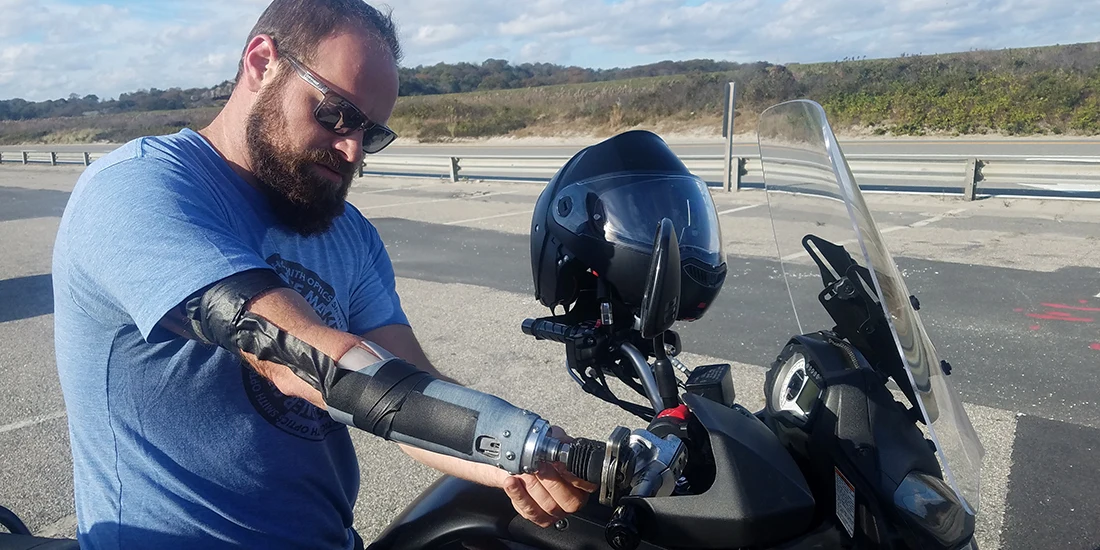& Construction

Integrated BIM tools, including Revit, AutoCAD, and Civil 3D
& Manufacturing

Professional CAD/CAM tools built on Inventor and AutoCAD
Aftermarket motorcycle parts are big business. Aftermarket Harley-Davidson parts comprise a smaller, yet still vibrant affair. Aftermarket parts for dedicated Harley owners who want to restyle their rides to look and act more like European racing bikes? That’s about as niche as you can get. But as Canada’s MJK Performance knows, it’s a narrow-but-deep pool of passionate customers who demand the best.
The Calgary-based manufacturer has provided custom Harley parts since 2007—always at the bleeding edge of new technologies. With a five-person staff, two 5-axis mills, one 3-axis mill, and a lathe, MJK Performance sells from its website and through a worldwide network of dealers. Designer and co-owner Phil Butterworth says his clientele is prepared to pay for the best results.
Butterworth says MJK Performance has been lucky during the pandemic’s social isolation, lockdowns, and resulting economic carnage. “We’ve got a nice, solid customer base, and it doesn’t seem to have affected them as much,” he says. “We also have a small crew up here, so it’s easier to stay safe. We’ve been very fortunate to still be busy and still running those 24-hour days. Production’s still ramping up.”
Adopting generative design was a natural next step for MJK, and it has resulted in a unique marriage of lightweight, high-performance parts that emulate the singular Harley Davidson visual philosophy. For their first foray into the technology, Butterworth and his team fixed their attention on the triple clamp. Stanchions from the telescopic fork are attached to the triple clamp, and sliders at the other end are attached to the front-wheel spindle.
“Our main objective is to make things as light and strong as possible, but we’re also known for nice-looking parts,” Butterworth says. “Triple clamps are normally big and bulky—probably one of our heavier items—so that’s what we focused on. We tried to get it at light as we could, but it couldn’t just look like something cheap we threw together.” The result was so successful that MJK went into production on it by the end of that week.
MJK’s engineers and designers had been aware of generative design, but the term had never evoked the visual style Butterworth wanted—until he jumped in.
“It always made me think of those spiderlike, organic, alien models,” he says. “I just thought it’d give us the same style only blockier, covered in intricate little pieces and looking silly. But when the model came back, it looked like something I would buy immediately. I was blown away. It looks racy; it’s got all the cool geometry. It has all the cool stuff generative does but in a style people understand and recognize. It was a no-brainer.”
After Autodesk Fusion 360 produced a range of designs for the triple clamp, Butterworth spent only about 20 minutes making tweaks to meet the design characteristics Harleys are known for: rounding edges, cleaning up corners, adding filets and radiuses. Because the performance simulation was already done in the software, he knew it would pass performance muster, leaving him free to concentrate on the visual appeal.
In fact, he went from the computer-generated model to having a part in his hands in a couple of hours. Butterworth says it was almost perfect straight out of the gate: Generative design slotted in with the traditional methods very nicely, with the algorithm getting the part 80%–90% of the way to the final result. “You more or less just add your logo and machine it,” he says.
Apart from its robust sense of visual style, MJK is known for turning around products quickly. Butterworth says going from computer model to real part within a day blew his mind, especially when the normal turnaround time for a design is one or two days.
“You’re learning as you move through it,” he says. “It can be a bit clunky at the start because I had no idea what I was doing. There were a lot of new terms I didn’t understand. But as you just jump in, the process is very intuitive.”
So far, MJK’s experience with triple clamps has been so successful that it’s looking at expanding to other products. “We’re experimenting with wheels, chain drives, and a couple of smaller products,” Butterworth says. “We haven’t quite got the results we want yet, but it’ll just take some playing around. And that’s got more to do with my learning more about it.”
And one of the biggest time-savers has been the ability to model, simulate, design, and refine all in Fusion 360. Despite having used the product for years, Butterworth says generative design has opened up countless new doors to explore.
“Having the editable model format was priceless,” he says. “Before I even start programming a mill, I know my part is going to pass any performance test. I don’t have to take it out and see if I can break it or spend time overengineering it. Whatever the weight optimization in the simulation does, the 2.5-axis generative design just gave us a solid model right away.”
Users can generate a cost estimate for each manufacturing method and design alternative, which in turn lets MJK stay nimble, picking the best manufacturing method in real time.
So, do MJK’s customers care about generative design? If the parts perform as needed, does it matter whether a human, a computer, or a combination of the two have produced it? Might it even be a selling point?
“It’s starting to really gain traction,” Butterworth says about his technology-savvy customer base. “People have heard standard machining and design terms for years, so when you start saying things like, ‘Our parts are generatively designed to become the lightest and strongest in the market,’ people start getting excited and looking for it. They want to see all that cool stuff.”
Considering Harley-Davidson’s rich history steeped in heavy, old-world techniques of visual form and manufacture, its design ethos may seem unlikely to rocket into the future of computer and cloud-designed machinery. But as MJK Performance melds the past and future of design and manufacturing beautifully, its customers couldn’t be happier.
After growing up knowing he wanted to change the world, Drew Turney realized it was easier to write about other people changing it instead. He writes about technology, cinema, science, books, and more.
Executive insights
PD&M
PD&M







